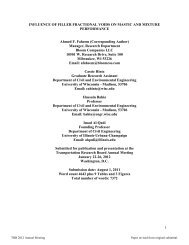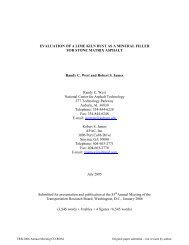DUAL MODE AND NEW DIESEL LOCOMOTIVE DEVELOPMENTS
DUAL MODE AND NEW DIESEL LOCOMOTIVE DEVELOPMENTS
DUAL MODE AND NEW DIESEL LOCOMOTIVE DEVELOPMENTS
You also want an ePaper? Increase the reach of your titles
YUMPU automatically turns print PDFs into web optimized ePapers that Google loves.
5<br />
10<br />
15<br />
20<br />
25<br />
Janis Vitins 5<br />
___________________________________________________________________________<br />
with a one-seat ride on services with mixed diesel and electric traction. It also enables railroads to<br />
switch off diesel traction under catenary, where diesel locomotives have previously been used.<br />
The ALP-45DP thus allows substantial fuel savings, diesel traction being substantially more<br />
expensive in overall than electric traction under catenary.<br />
Figure 2: The ALP-45DP for AMT (left) and NJT (right).<br />
The challenge in the design of the ALP-45DP was to provide sufficient power ratings in both<br />
electric and diesel mode under the constraint of a maximum axle load of 72’000 lbs (32.66 tons)<br />
and meeting the required FRA standards 49CFR 229&238. This was done using the latest<br />
technologies already incorporated in the electric locomotive ALP-46A for the carbody, trucks,<br />
propulsion and control & communication. Also, the operators cab is basically identical to that of<br />
the ALP-46A, with additional functions for diesel traction. The fuel tank has a capacity of 1’800<br />
US gal and is an integral part of the carbody structure. It consists of four separate compartments of<br />
450 US gal each in order to fulfill the stringent requirements of fire safety in tunnels. The trucks<br />
are derived from the German locomotive BR 101 and are of the same basic design as is used on<br />
the ALP-46 locomotives, however, adapted to the higher axle load.<br />
The major engineering challenge was to install both the diesel engines and the electric<br />
traction equipment with the space and weight restrictions of a 4-axle locomotive. Two Caterpillar<br />
3512HD high speed engines were chosen for the diesel mode. One advantage of these engines is<br />
that they can provide high acceleration, essential to achieve short traveling times between stations.<br />
Also, they meet Tier3 exhaust emission standards. A solution is now being prepared to meet Tier4.<br />
The disposition of equipment within the locomotive is shown in Figure 3. The traction converter is<br />
positioned in the center of the locomotive with the transformer directly beneath it. This<br />
arrangement has the advantage of short power cables between them. The two diesel engines are<br />
mounted left and right of the converter providing largely a symmetric layout and thus facilitating<br />
the weight balance of the locomotive. The cooling systems are installed in the roof sections<br />
TRB 2012 Annual Meeting Paper revised from original submittal.




